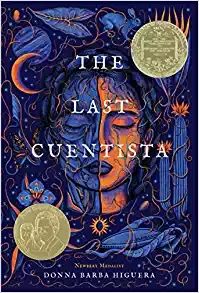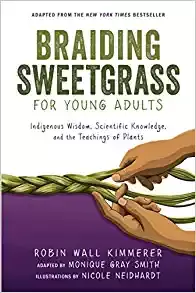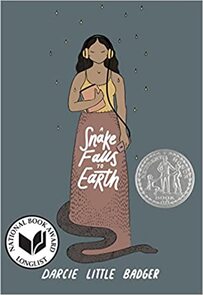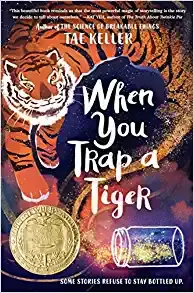| We are thrilled to have Dr. Fawn Canady as our first post for 2023! Dr. Canady is an Associate Professor of Adolescent and Digital Literacies at Sonoma State University in Northern California. She is a former high school English teacher. Her interdisciplinary interests include multimodality, adolescent literacies, and teacher education. |
--Robin Wall Kimmerer
For those of us in school, it’s Winter Break. The winter solstice, the longest night and shortest day of the year, is behind us. From here, the days grow longer. Imperceptible at first– but each day now, our days will be lighter and longer. Still, it is winter and the time for storytelling. So, in this post, I will center YA novels that evoke oral storytelling traditions.
What Distinguishes Storytelling from Written Stories?
Storytelling, particularly oral stories passed down through generations, connects us in myriad ways. I hear my old English professor proclaiming the purpose of storytelling as “to instruct and delight!” From stories, we learn. They serve an aesthetic purpose. Stories are also vehicles for collective memory, conveying our past. Stories have the power to shape our identity, inform what kinds of people we hope to be. And, stories situate us in time. All of these reasons have drawn me to oral histories, too.
Recently, NCTE released the Teaching Storytelling Position Statement, which defines storytelling thus:
Oral storytelling is different from personal narrative writing such as memoir or autobiography in that it is told in front of a live audience (of one or more), it involves at least some improvisation, and it utilizes the extra dimensions of dialect, vocal shadings, audience response, and accompanying facial and body movements (Simons, 1990). …The performance aspect of oral storytelling adds an extra layer to the already complex act of narration found in genres more familiar to the classroom, such as memoir. When done well, the craft of oral storytelling actually produces oral literature; good oral stories are verbal art, but deeply entrenched ethnocentric and elitist biases have established an image of them as formless, simple, and plebeian (Bauman, 1986, p. 7). Allowing students to perform stories in their own, personal language can legitimize and honor their individual ways of speaking in a way school spaces usually don’t.
I quote this nearly in full because the following books include examples of characters telling or listening to stories or the authors adopt the cadence or styles of storytelling. Additionally, the following YA novels remind readers of the “verbal art” that students are invited to “perform…in their own, personal language.” In English language arts classrooms, we want to encourage students to create as well as read. Furthermore, each of these novels “legitimizes and honors [students’] individual ways of speaking in a way school spaces usually don’t.” In a time when teachers look to engage students' lived literacies and further linguistic justice (Baker-Bell), YA novels that emphasize storytelling invite students’ community cultural wealth (Yosso) into the classroom. It also creates a space for them to lean into the stories central to cultures different from their own. Lastly, in this spirit of Xito Institute, it invites all of our ancestors into our learning spaces.
The Last Cuentista, by Donna Barba Higuera, is an award-winning YA sci-fi novel in which storytelling, specifically Mexican folklore, plays a key role in shaping the future of humanity. The story begins in the near future, with 12-year-old Petra Peña and her Abuela, Lita, sitting near a piñon fire in the desert in the shadow of the Sangre de Cristo Mountains in New Mexico. Lita is telling Petra the story of the Fire Snake nagual (also known as Haley’s comet), which is on a collision course with earth. The only hope for humankind is to leave the planet earth. This is one of many, many stories that Lita has told her children and grandchildren. This one, however, she “makes her own '' and encourages Petra not only to remember the stories, but to make them her own when she arrives on her new planet. Her new home.
Petra’s family has been selected to leave earth to save humankind. Three ships will launch farmers, scientists, doctors, and others deemed essential to the new colony. It will take over 370 years to arrive, so they will be in stasis. Monitors and their descendants will watch over the sleepers until arrival on Sagan. As they sleep, En Cognito Downloadable Cognizance, a kind of futuristic, super Wikipedia of specialized knowledge, will be loaded in their brains as they sleep for hundreds of years. Petra’s parents have chosen botany and geology (their expertise) for her. But, for her “elective,” she chooses mythology and stories. She wants to be a storyteller like Lita.
So as not to spoil the story, I’ll simply say that there are some on the ship who believe that peace and harmony are possible for humanity but at great personal sacrifice for the greater or collective good. And thus, Petra is awakened early to a nightmare scenario. She must find a way to preserve the stories of humanity against the Collective, which sees individuality and difference as dangerous to the common good.
There is so much more to say about this book, but in this post, I’m focusing on the storytelling tradition. Petra soon finds that of all of the “useful” arts and sciences, storytelling is the most powerful tool for hope and change. The traditional Mexican folklore, beginning with familiar or patterned phrases such as “Érase que se era…” or “In the beginning,” or “Once upon a time,” can be used by Petra to shape a more humane future for people. Beloved stories, such as La Llorona and indigenous creation stories tied to place are modified to reflect her surroundings. Thus, while stories retain their core meanings, they can also adapt to new places, new situations. In other words, the stories passed down orally over time have the power to guide people through time and space.
In the Teaching Storytelling Position Statement, storytelling is presented as essentially universal. It is a practice of sharing space with another, where there is a certain kind of reciprocity between the teller and listener, just as Lita and Petra do in the first chapter. Storytelling in Cuentista is the vehicle through which identities are shaped and connections are made between ancestors and families. Storytelling is about sensemaking–and also about living in a way that, as Petra and her brother say in the book, has the potential to be momentous: “Everything we do from this moment on will bring great pride or great sadness to our ancestors.”
Storytelling is a collective memory and is also individual. Memory is important in Cuentista. Memory is triggered by stories and by objects that evoke stories of individual experiences. For example, a children’s story beloved by Petra’s little brother, Dreamers (Morales), triggers his memory. Much of Cuentista is reflected in Dreamers. For example, there are items that the space travelers brought with them, such as pendants, wedding rings, images, baseball cards, kitschy sweatshirts, and toys… all things that are rich with meaning for their person. In Dreamers, the young mother in the story packs her precious belongings in a backpack. It makes you wonder, if you had to leave the planet, never to return, what would you bring? What memories and stories would be revived by those things? What would your stories communicate to the future?
The knowledge prized in Cuentista comes from STEM fields and stories are seen as a threat. Yet, stories also contain other kinds of knowledge passed down from ancestors. In Braiding Sweetgrass for Young Adults: Indigenous Wisdom, Scientific Knowledge, and the Teaching of Plants, all living things provide knowledge and gifts. These teachings are conveyed through storytelling. Botanist Dr. Kimmerer, along with author Smith and artist Niedhardt, shows young readers how scientific knowledge is not necessarily different from, and certainly not necessarily superior to, the wisdom reflected in stories about the natural world. This is a book that reacquaints, or tunes our senses, to learning from the land. This restorying begins in “An Invitation to Remember,'' at the beginning of the book, where we are invited to “remember another way of being in the world, in kinship. To be in relationship with all living things, our relatives” (p. 10). Importantly, we have agency, an opportunity to imagine the future we want for all of creation:
“We are in the time of the Seventh Fire, a time prophesied by my Anishinaabe ancestors. A sacred time when our shared remembering transforms the world. A Dark time and a time filled with light. We can choose to live in the dark or the light. We remember the oft-used words of resistance, ‘They tried to bury us, but they didn’t know we are seeds.’
Braiding Sweetgrass is a perfect pairing with Cuentista. They complement each other through the role of storytelling in carrying teaching and wisdom, but also in shaping the future.
A few other books come to mind when I think about the role of storytelling across time. A Snake Falls to Earth tells the story of Nina, a Lipan Apache girl in the future who believes in the old stories. Darcie Little Badger writes in a way that evokes Lipan Apache storytelling. In other words, the cadence of oral storytelling adds to our reading. In the story, two worlds come together to reveal that the old stories are true in a way that they haven’t been in recent memory. Readers will think about the Fire Snake and other stories shared by Lita and Petra in Cuentista. Similarly, When You Trap a Tiger shares the themes of storytelling and connections to family. It is about a Korean folktale that is closer to truth than fiction. I say that with a qualifier, thinking of a friend, Alan Rosen, who reminds us that fiction can also communicate essential truths. Even through sci-fi, magical realism, and speculative fiction, each of these stories ask us to examine the ways we make distinctions between fiction and reality or “truth.”
Centering storytelling encourages us to honor the oral traditions passed on through time. These stories present storytelling as essential not only to our identities but to living our best possible lives in kinship. Storytelling is a practice that young people engage in all of the time. I am also reminded of the resurgence of Spoken Word in schools, or of drama or poetry– dramatic retellings. Each of these invites us to consider the ways that storytelling has influenced the language arts. Students can also create audio or multimodal stories that reflect participatory storytelling practices. Or, they can simply settle in and tell a good story. It’s the perfect time for it.
References
Baker-Bell, A. (2020). Linguistic Justice: Black Language, Literacy, Identity, and Pedagogy. Routledge.
Higuera, D. B. (2021). The Last Cuentista. Levine Querido.
Keller, T. (2020). When you Trap a Tiger. Random House Books for Young Readers.
Kimmerer, R. W., Smith, M. G., & Neidhardt, N. (2022). Braiding Sweetgrass for Young Adults: Indigenous Wisdom, Scientific Knowledge, and the Teaching of Plants. Zest Books.
Little Badger, D. (2021). A Snake Falls to Earth. Levine Querido.
Yosso*, T. J. (2005). Whose culture has capital? A critical race theory discussion of community cultural wealth. Race ethnicity and education, 8(1), 69-91.






 RSS Feed
RSS Feed